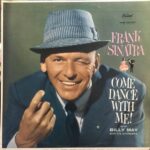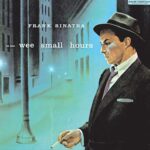
“SINATRA AND COMPANY” (1971)
By Mahnuel Muñoz
Frank Sinatra began the 1970s as a tired and adrift voice, searching for that new song to rekindle the flame that for thirty years had been able to heat the Paramount Theatre, the Hollywood Bowl, the Sands of Las Vegas and the rooms of their fans, bringing out all the shine to the most dazzling of the Great American Songbook.
Mired in the transcendental dilemma of whether or not to continue with his career, despite being still young – 54 years old – Sinatra felt like “The Man in the Looking Glass” from his 1965 song. He could hear the relentless ticking of the clock, reminding him of his fragile humanity. The nights out were more difficult to endure the next day, the sexual vigor was not as overwhelming as it used to be, his voice failed more times than desired and he felt the desire to wage battle in a cultural panorama in which there seemed to be no place for him. When the headlines mentioned his name, they did not do so to talk about his art, but rather to report on the well-known issue of the mafia, his ideological transition towards conservatism and the altercations he continued to cause in Las Vegas, understandable for a young rock star but unheard of in a mature performer of popular songs.
On lige concerts he continued to make an impressive display of unparalleled class and magnetism; The November 1970 recital at the Royal Festival Hall in London, captured on video, is sufficient as an example. But with the studio work, the one intended to preserve his legacy for future generations, it did not conveniently channel the flow of emotions that he kept within him. His most recent and risky recording works, “A Man Alone” (1969) and “Watertown” (1970) had not been understood, because they presented sonorous and interpretive nuances unknown among his traditional audience and difficult to decipher for the youth audience.
The 1970 recording sessions, held between October 26 and November 2, revealed a Sinatra trying with some erratics to renew his sound based on melodies by young composers and arrangements by Don Costa: a jubilant and frugal tone in forays pop with undisguised commercial objectives (“Sunrise In The Morning“, “Leaving On A Jet Plane“, “Close To You“, “Life’s A Trippy Thing“, “Feelin’Kinda Sunday“); the triumphant Sinatra tone of “My Way ” (“I Will Drink The Wine”, “I’m Not Afraid“) and the most interesting, at least for me, the soft and sad ballads with a folk and naive approach (“The Game Is Over“, “My Sweet Lady” and “Bein’ Green“), a kind of update of the softer and more candid Sinatra of the 1940s. That restful, taciturn and philosophical Sinatra, on the eve of a second process of artistic death-and-resurrection found unexpected but accurate ways of expression in the works of John Denver, Paul Ryan, Burt Bacharach and Joe Raposo, among other brilliant young people.
Oddly, some of the best songs recorded during those sessions were left out of the repertoire, forcing Reprise to mix the chosen songs with some of the material recorded in February 1969 for the aborted “SinatraJobim“, an attempt to repeat the success. harvested by Sinatra’s album with Antonio Carlos Jobim in 1967. The unborn album is an envelope full of beautiful postcards that encapsulate the aromatic rhapsody of Brazil as it passes through the golden gorge of Hoboken, which at that time dazzled with a regal beauty autumnal. The orchestral setting, signed by Eumir Deodato, offered a less intimate approach than the 1967 album, with more prominent wind arrangements, achieving moments full of swing (“One Note Samba“, “This Happy Madness“) and unforgettable moments by the emotionality and interpretive virtuosity of the singer (“Don’t Ever Go Away“, “Wave“).
“Sinatra & Company” is, as a result of such a difficult mix, a pair of mini LPs with no other connection to each other than Sinatra’s Voice, but somehow it triumphs in the task of preserving in amber an unusual moment of indefinition in the future of the artist.
“The Songs That Got Away…“
The most valuable outtakes from the 1970 sessions – in my opinion – were unfairly exiled to “Frank Sinatra Greatest Hits Vol.2” (1972) and to the comprehensive box set “The Complete Reprise Studio Recordings” (1995). The aforementioned songs are Frank’s first version of George Harrison‘s “Something“, “I’m Not Afraid” – which has its origins in a song by Jacques Brel titled “Fils de” and included on his album “Jacques Brel 67 ” and was adapted into English by Rod McKuen – and “The Game Is Over“, a sad ballad by John Denver that speaks of lost loves, which in the historical context in which Frank Sinatra recorded his version can well be reinterpreted as a farewell :
“Time, there was a time
You could talk to me without speaking
You would look at me
And I’d know all there is to know
Days I think of you
And remember the lies we told in the night
The love we knew
The things we shared
When our hearts were beating together
Days that were so few
Full of love and you
Gone, the days are gone now
Days that seem so wrong now
Life won’t be the same without you
To hold again in my arms
To ease the pain and remember
When our love was the reason for living
Days that were so few
Full of love and you
The game is over“
And Frank Sinatra had everything ready to retire, something that he would announce shortly after and he would make it effective on June 13, 1971 with an emotional concert at the Ahmanson Theater in Los Angeles.
Well, Sinatra’s recording of “The Game Is Over“, adorned with Don Costa’s arrangements, was not published either on an LP or on a single album, although it possibly would have been a success due to the emotional impact of the song after the goodbye – luckily, temporary – of Frank Sinatra.
“Sinatra & Company” only managed to reach number 73 on the US charts and a much more creditable ninth place in the UK. It has been an underrated LP as it does not follow the conceptual line of the great works of The Voice, but it presents moments of moving intensity that make it worthy of a reevaluation based on the historical context in which it was created, the personal circumstances of the artist and, Above all, the multifaceted musical beauty that awaits us in the microgrooves.
TRACK LIST
“Drinking Water” (Vinicius de Moraes, Antônio Carlos Jobim, Norman Gimbel) – 2:35
“Someone to Light Up My Life” (de Moraes, Jobim, Gene Lees) – 2:37
“Triste” (Jobim) – 2:40
“Don’t Ever Go Away (Por Causa de Você)” (Ray Gilbert, Dolores Durán, Jobim) – 2:28
“This Happy Madness (Estrada Branca)” (de Moraes, Jobim, Lees) – 2:57
“Wave” (Jobim) – 3:25
“One Note Samba (Samba de uma Nota Só)” (Jobim, Newton Mendonça, Jon Hendricks) – 2:20
“I Will Drink the Wine” (Paul Ryan) – 3:30
“(They Long to Be) Close to You” (Burt Bacharach, Hal David) – 2:34
“Sunrise in the Morning” (Ryan) – 2:50
“Bein’ Green” (Joe Raposo) – 3:00
“My Sweet Lady” (John Denver) – 3:01
“Leaving on a Jet Plane” (John Denver) – 2:25
“Lady Day” (Bob Gaudio, Jake Holmes) – 3:41
Charts
















